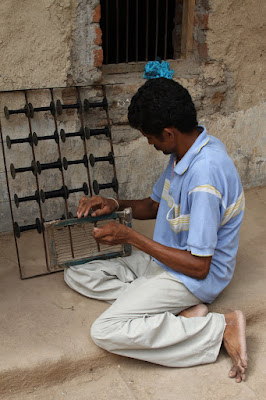Recently I had a chance to visit village of Dedadra in Surendranagar district and see unique textile tradition of Tangaliya weaving and interact with craftspeople.
Gujarat,western most state of India,has always been famous for its textile traditions. Surendranagar district of Gujarat is one of the largest producer of "Shankar" cotton in the world. No wonder many textile traditions, like Tangaliya weaving, Khadi , single Ikat have flourished in this region.
Arid land of Surendranagar District
Tangaliya, 700 years old hand weaving technique, is native to Gujarat. Traditionally it is woven by Dangasia community of Surendranagar district. Dedadra village is one of the main clusters for Tangaliya weaving.
Dedadra Village
There is an interesting story behind Tangaliya art. According to folklore one Bharwad (shepherd) boy fell in love with daughter of weaver and married her. This displeased his family and he was thrown out along with his wife. So he settled down with his in-law's family and continued to herd sheep. Slowly he learned art of weaving from them. He used sheep wool for his weaving and started weaving shwals. Thus the art of Tangaliya weaving was developed. Today it is woven using varieties of yarns like cotton,merino wool and eri silk. Product line has also developed keeping in mind modern requirements.Interesting sidelight to this story is that, today this art is not taught to daughters of the family, as daughters can pass on this knowledge to other families when they get married and create competition for existing craftsmen!! Idea of protectionism exists since ages it seems!
Bobbin being prepared out of yarn
Creel
In summers and winters,warp is prepared in the open while in monsoon it is done indoor.
Yarn is ready for weaving.
Warp is ready.
Tangaliya weaving is very labour intensive process. It is special technique of weaving where dana-work (bead of yarn) is done using cotton yarn. Bead is formed by tying yarn on 2,3, or 4 warps depending upon design. This also brings out design on both sides of fabric.
Attaching a dana(yarn bead)
Traditionally weaving is done on pit looms ,though at some places now frame looms are also being used.
Weaving in progress.
Fabric is ready.
Unfortunately today this beautiful art has no takers. Government has give "GI"(Geographical Indication) tag to this crafts which means quality assurance and also defines facts of its origin. But no follow up measures are taken by government for marketing of this product. Weavers lament their woes. Many of weavers do weaving only part time as they do not get sufficient work. More and more of them are now leaving their traditional craft. They prefer to work as farm labourers rather than do weaving as it provides them with continuous work. Is this end of road for this hand weaving craft too? It seems it will soon die and future generation will not enjoy beauty of this wonderful craft.
Hands that weave
tell thousand tales
of relentless toils.
Patterns and weaves
come and go
in thread he weaves.
His soulless eyes
search
designs of his dreams.
Reds and Greens
just remain
on the beam.
White and black
and hues of Grey
paint his life grim.
solitary figure
bending on his loom
in airless room
waits for his doom.
Future unknown
he bemoans.
Please note:
All my photographs are (C) Copyrighted and All Rights Reserved.
None of these photos may be reproduced and/or used in any form of publication, print or the Internet without my written permission.
If you want to use them please contact me.




















Such a beautiful story!! Great series of pictures as well.. Really really like this one Sonali.. :)
ReplyDeletehey, we are students from NID, Ahmedabad.
ReplyDeletewe loved your work and would like the cover the craft of weaving tangaliyas as part of our design project.
It'ld be great if you could give us some contacts and information about the place and people.
Please let me know your name and e-mail address, so that I can forward the details.
ReplyDeleteHello Sonali,
ReplyDeleteWould it be possible to send across to me how to reach the Tangaliya weavers and any possible helpful information about them.
You can mail me at ashik.kalam@gmail.com
Hi Sonali,
ReplyDeleteI'd really love to learn more about these weavers- what they can weave etc. would you be able to send me some details about the community and also any contact details you might have for them? my email is emmaavery02@gmail.com
Thanks,
Emma
I have sent you an e-mail. Thanks.
ReplyDeleteHi Sonali,
ReplyDeleteI would love to know more about their weaving and work. Please could send you share some details, along with the contact details for the community on sampatmanjari@gmail.com.
Thanks
hi, great work sonali. i am social entrepreneur in rajkot. please give me address & contact. i might help. drkomalmakwana@gmail.com
ReplyDeleteHello, i am student and my group and i are making a document on Tangalia weaving and we would like to get your consent to use your photos for the presentation that we a making.
ReplyDeletemy email id is anjalialisha21@gmail.com, and i would we very thankful to you if you can get us persmission to use your photos for our work
ReplyDeleteMarvelously naratted through both text and images.
ReplyDeleteMarvelously narrated and explained through text and images.
ReplyDeleteHI sonali I loved the poem. I am a student and would like to quote your poem in my document on Tangaliya weavers in Surendranagar. It really captures the essence of the life they lead. Let me know if that would be acceptable to you.
ReplyDelete